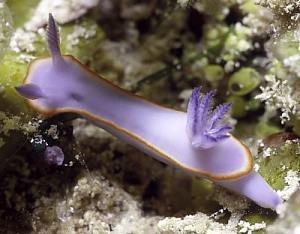
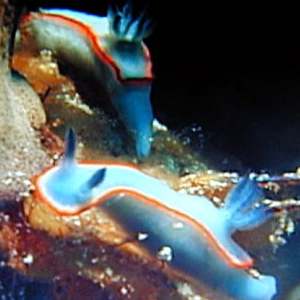
Hypselodoris nyalya
(Marcus & Marcus, 1967)
Order: NUDIBRANCHIA
Suborder: DORIDINA
Superfamily: EUDORIDOIDEA
Family: Chromodorididae
DISTRIBUTION
Caribbean [Florida, Bahamas, Cuba]
PHOTO
Upper: Southern Bahamas, August 2002. Photo: Paul Young.
Lower: Orange Cay, Bahamas. at 60 feet, May 11, 2003. Photo: Larry Townsend
Unfortunately the original description is based on 2 preserved animals from Florida. The one colour photo shows a fairly dark blue animal and a red mantle border. Another photo (Humann, 1992) also shows a dark blue animal but the border appears to be multicoloured - red on the outside then yellow orange, and white on the inside. The upper animal illustrated here appears to be a pale version of that. Marcus & Marcus place the species in the genus Chromodoris but the shape of the radular teeth, the narrow ribbon, the shape of the jaw plates, and the position of the mantle glands suggest this is most probably a species of Hypselodoris, although Ortea et al (1996) suggest it should be placed in Risbecia. I only know of these three previous records of the species.
References:
• Humann, P. (1992) Reef Creature Identification - Florida, Caribbean, Bahamas.
• Marcus, Er. & Marcus, Ev. (1967) American opisthobranch mollusks. Part 1, Tropical American opisthobranchs. Studies Tropical Oceanography, Miami, 6(1-2): 1-137. (Figs 1-150, Pl.1, figs 1-9)
• Ortea, J., Valdes, A. & Garcia-Gomez, J.C. (1996) Review of the atlantic species of the Family Chromodorididae (Mollusca: Nudibranchia) of the blue chromatic group. Avicennia (Suppl. 1): 1-160.
Rudman, W.B., 2003 (May 28) Hypselodoris nyalya (Marcus & Marcus, 1967). [In] Sea Slug Forum. Australian Museum, Sydney. Available from http://www.seaslugforum.net/find/hypsnyal
Related messages
Hypselodoris nyalya from Kay Largo, Florida
August 10, 2007
From: Paul Osmond
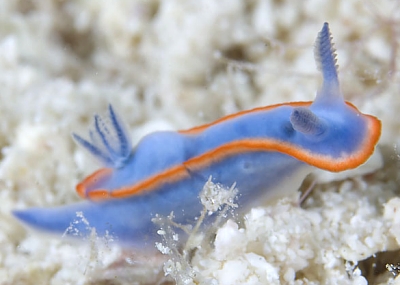
Hi Bill,
Had a quick trip to Florida for business and had a chance to dive for a few days in my old backyard in Key Largo, Florida. During a dive on Conch Reef, we observed this specimen of Hypselodoris nyalya moving across the coral reef.
Locality: Key Largo, 20m, Florida, USA, Atlantic, 13 May 2007, Coral Reef Ledge. Length: 25mm. Photographer: Paul T. Osmond.
Seems to be my privilege to have now seen this species in more than one location. This one was significantly larger than any of the previous grouping that I found in Bimini a few years ago and I got much better images this time around as well.
Yours,
Paul
www.deepseaimages.com
marriard@deepseaimages.com
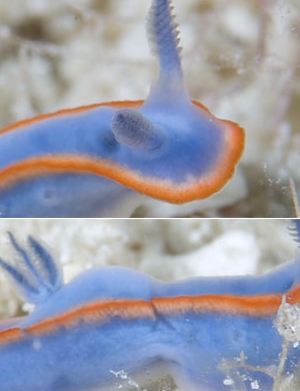
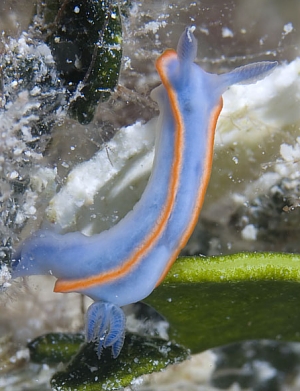
Dear Paul,
Thanks for these nice photos. I have included a couple of close-ups to show what look like mantle glands around the mantle edge. They form a continuous whitish band of small glands right around the mantle. Looking back in earlier photos I can see signs of the same whitish band in those specimens as well. This is quite puzzling because Marcus & Marcus (1967), when they described this species, specifically mention and illustrate a quite different arrangement of mantle glands - " the notal border bears glands .. two antero-lateral groups and a postbranchial semicircle of seven glands.. " and their drawing shows large spherical glands like we find in Hypselodoris, Risbecia and related genera. It was originally placed in Chromodoris but I suggested it should be moved to Hypselodoris and Ortea et al (1996) suggested it should be moved to Risbecia. Certainly the Forum records of it feeding on Dysidea etheria (see Rudman & Bergquist, 2007) support its relationship to the Hypselodoris - Risbecia branch of the chromodorids, as do the shape of the radula teeth as reported by Marcus & Marcus. However, if this whitish band is the mantle glands, then I think the whole anatomy of this species needs to be looked at, in particular its reproductive system, which we know nothing about, and its position in the chromodorids re-evaluated.
-
Marcus, Er. & Marcus, Ev. (1967) American opisthobranch mollusks. Part 1, Tropical American opisthobranchs. Studies Tropical Oceanography, Miami, 6 (1-2): 1-137. (Figs 1-150, Pl.1, figs 1-9)
-
Ortea, J., Valdes, A. & Garcia-Gomez, J.C. (1996) Review of the atlantic species of the Family Chromodorididae (Mollusca: Nudibranchia) of the blue chromatic group. Avicennia (Suppl. 1): 1-160.
-
Rudman, W.B. & Bergquist, P.R. (2007) A Review of feeding specificity in the sponge-feeding Chromodorididae (Nudibranchia: Mollusca). Molluscan Research, 27(2): 60-88
Best wishes,
Bill Rudman
Chromodoris nyalya
June 19, 2006
From: Bill Gomez
In May 2006 I saw a nudibranch that I believe is the same as or closely related to what my text by Paul Humann (Reef Creature Identification- Caribbean) identifies as Chromodoris nyalya, the Red-line Blue Sea Goddess. I saw a pair on algae that looked very similar in all aspects except the overall body color was cream rather than blue. All other markings and form seemed the same as his photo. Sorry, I have no photograph. I saw them in Abaco, the northern Bahamas. I was surprised that a search of your data base did not come up with this species. Has there been a name change?
Locality: Pelican Harbor, 3 meters, Abaco, the Bahamas, Atlaantic Ocean, 30 May 2006, sandy bottom with grass and algae. Length: approx. 1 cm. Photographer: none.
Bill Gomez
Atherton, Ca, USA
bgomez1@stanford.edu
Gomez, W., 2006 (Jun 19) Chromodoris nyalya. [Message in] Sea Slug Forum. Australian Museum, Sydney. Available from http://www.seaslugforum.net/find/16897Dear Bill,
Although I haven't the name of every species of nudibranch listed, Chromodoris nyalya is but under the name Hypselodoris nyalya. From the anatomical information available I am pretty sure that Hypselodoris is the correct place for this species. If you are looking for a species on the Forum it always pays to search just for the species part of the name - in this case nyalya - rather than Chromodoris nyalya - because most of the common name changes involve a change of genus - in this case from Chromodoris to Hypselodoris.
As you will see from the messages we have on the Forum about this species, there can be some variability in the background colour. It would have been nice to have a photo of your cream variety.
Best wishes,
Bill Rudman
Hypselodoris nyalya feeding
March 8, 2004
From: Marina Poddubetskaia
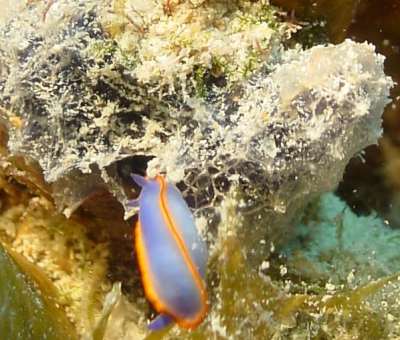
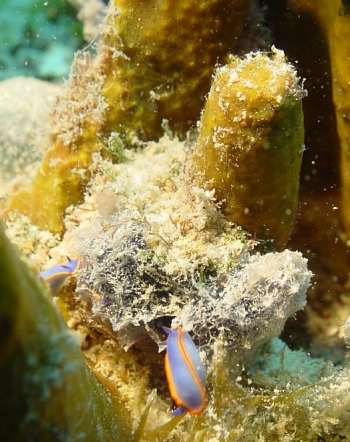
Dear Bill,
On the Forum, I can see a message of Paul Osmond about Hypselodoris nyalya [#10156]. It's funny because I saw an aggregation of this species, on the same sponge and in the same place too. But this year the specimens were less numerous, less than 10. Probably because of the small quantity of remaining sponge. Did you succeed in identifying this grey sponge ?
Bimini Islands, Bahamas, Western Atlantic. Site: The Sapona (wreck). Depth: 4m. February 08, 2004.
Size : 20mm and 25mm
Photos: Marina Poddubetskaia - Nembro website
Best wishes,
Marina.
nembro@nembro.info
Poddubetskaia, M., 2004 (Mar 8) Hypselodoris nyalya feeding. [Message in] Sea Slug Forum. Australian Museum, Sydney. Available from http://www.seaslugforum.net/find/12394Thanks Marina,
It's certainly nice to get confirmation on the sponge food of this species. We are making progress with sponge indenifications, and extra photos like this make the job easier. Sponge identifications from photographs can sometimes be tricky so I would rather go slowly and make sure we get it right first time. You can be sure I will popst the identifcations on the Forum when we have them sorted out.
Cheers
Bill Rudman
Hypselodoris nyalya from Florida
November 18, 2003
From: Linda Ianniello
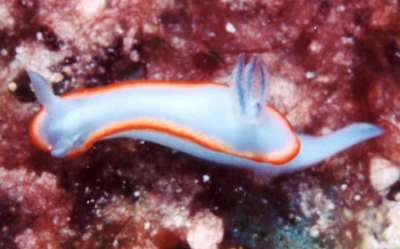
Hi, Dr. Bill,
Here is an image of a Hypselodoris nyalya we found in the Florida Keys at Molasses Reef, to round out its Caribbean sightings.
It was found November 9, 2003, at a depth of 25 feet, and was very small, about 1/2 inch.
Regards,
Linda Ianniello
lindai@us.ibm.com
Ianiello, L., 2003 (Nov 18) Hypselodoris nyalya from Florida. [Message in] Sea Slug Forum. Australian Museum, Sydney. Available from http://www.seaslugforum.net/find/11429Thanks Linda,
It's nice to get a photo from Florida, because it was first described from 2 preserved specimens from Florida
Best wishes
Bill Rudman
Hypselodoris nyalya from Bimini, The Bahamas
June 7, 2003
From: Paul Osmond
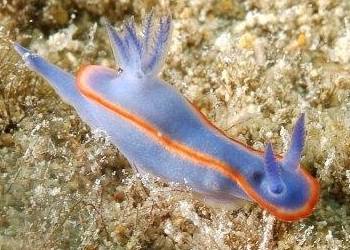
Dear Bill,
There is an extremely large population of Hypselodoris nyalya of these nudibranchs living on the wreck of the Sapona in Bimini [Bahamas] in about 20' of water. They are very small, with none being larger than an inch in size. On the single dive I did on the site in March 2003 I found 25-30 specimans. They are easy to over look, an I was only sure they were nudibranchs when I found a speciman in the open and well lit by the sun. The group of 6 pictured were so small it took several close looks to conclude that they were indeed nudi's.
You can see a gallery of 7 images of this species at http://www.deepseaimages.com/dsilibrary/showgallery.php?cat=828&thumb=1
Paul Osmond
marriard@deepseaimages.com
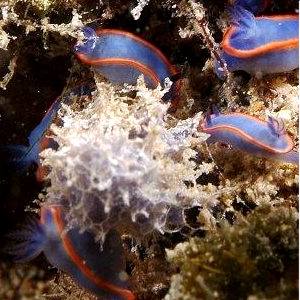
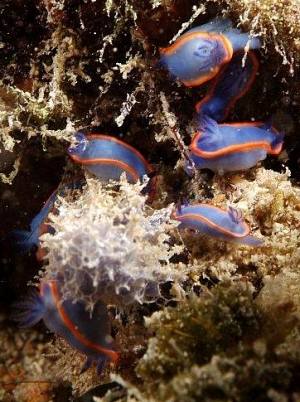
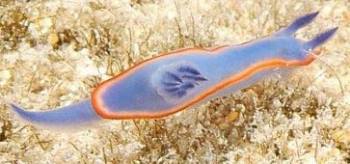
Thanks Paul,
This is an interesting record, suggesting it is probably not as rare as the very few records we have of it suggest. I suspect the group of animals were all clustered around a colony of their food sponge, which I am in the process of getting identified.
Best wishes,
Bill Rudman
Hypselodoris nyalya from the Bahamas
May 29, 2003
From: Larry Townsend
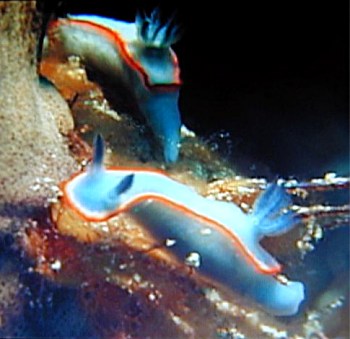
Dear Dr. Rudman,
I found this pair of nudibranchs on May 11, 2003, on Orange Cay in the Bahamas. They were in 60 feet of water on a combination of sponge and hydroids.
These images are from my video of them and the quality is not very good but I hope you will be able to identify them. The body and mantle were translucent white and the mantle was bordered with a red band. The tail was white and had no markings. The rhinophore were blue with rings, and the gills were blue. One of the pair was missing a rhinophore. Are they a color form of Glossodoris sedna?
Thank you for your time.
Larry Townsend
Delray Beach, Fl USA
orcaman@bellsouth.net
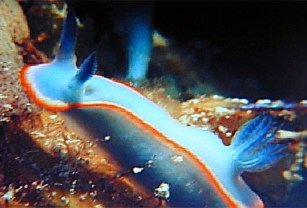
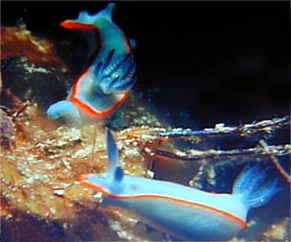
Dear Larry,
This is an interesting find. It is Hypselodoris nyalya, which has seldom been found since its original description. The blue body and reddish border fit the Marcus's description of Hypselodoris nyalya much better than the pale colour form in Paul Young's photo.
Best wishes,
Bill Rudman
Nudibranch from Southern Bahamas
September 10, 2002
From: Paul Young
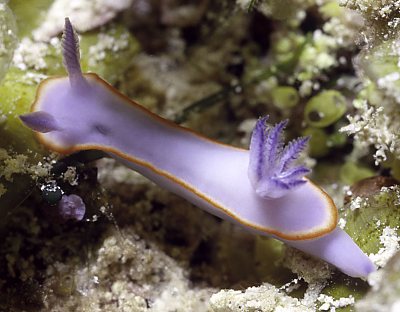
Charlotte and I took a small vacation to the southern Bahamas. I photographed this nudibranch. Can you identify it?
Paul
young@underwater.org
Young, P., 2002 (Sep 10) Nudibranch from Southern Bahamas. [Message in] Sea Slug Forum. Australian Museum, Sydney. Available from http://www.seaslugforum.net/find/7911Dear paul,
This is an interesting find. I am pretty sure it is Hypselodoris nyalya. Unfortunately the original description, by Marcus, is based on 2 preserved animals from Florida. The one colour photo shows a fairly dark blue animal and a red mantle border. Another photo (Humann, 1992) also shows a dark blue animal but the border appears to be multicoloured - red on the outside then yellow orange, and white on the inside. I think your animal is a pale version of that.
I only know of these two previous records of the species.
Best wishes,
Bill Rudman
